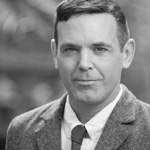The landscape architecture firm Nelson Byrd Woltz is dedicated to the integration of respect for nature and design. They will be partnering with the Brooklyn Greenway Initiative, one of our National Award winners, on the Naval Cemetery Landscape project to develop a peaceful natural space for commuters along the greenway.
We had a chance to sit down with Thomas Woltz, FASLA, CLARB, Principal of Nelson Byrd Woltz, and Jeffrey Longhenry, Senior Associate on the Naval Cemetery project, to discuss their approach to this particular landscape design.

Open Voices: What role do you envision having in the development of the Naval Cemetery Landscape project?
Thomas Woltz: The role of Nelson Byrd Woltz will be to envision a sustainable landscape design for this important, sacred ground that reveals the many layers of history of the site. It’s a design meant to honor not just the individuals buried there — many of whose names we do not know — but also to honor the cultural traces of this place as a farm, then a hospital burial ground, and a navy yard burial ground, and to remind people that the stories of land live on and uses change.
The other layer is to try and build a transformative landscape that builds a very healthy and resilient ecology. So the concept is to transform the site into a warm season grass meadow with native wildflowers to create a highly impactful pollinator meadow to support the critical pollinators for the community gardens that are in Brooklyn and Manhattan. We saw attracting as much life as possible to the site as a poetic response — as a way to honor a place of memorial and death historically.
Open Voices: The philosophy of Nelson Byrd Woltz is cited as centering “on design that honors and reveals the local history and natural context of a site through a process of observation, creative interpretation, and construction.” Can you explain a little more about how you implement these principles in your planning and designs?

Thomas Woltz: Our process generally starts with a heavy research component where we look at everything from tax maps, city maps, and historic photos to understand former uses . And that’s when Jeffrey came across the maps of the former farmland that once occupied that part of Brooklyn, with orchards in particular, and then looked at the way the naval yard had developed over time. We’re really looking back to try and form a position on how to look forward. Our designers try to root themselves in a careful reading of the place and its past lives.
We then look with equal rigor to the native ecology of the place. In many cases we team with conservation biologists to do analysis of the site and its region to find out what ecological structures or plant communities or soil types are missing; what are some threatened or endangered species that we can help; or how can our landscape architectural solution resonate with, respond or repair an ecology.
Then the third piece is the commission from the clientr. In this case the Brooklyn Greenway Initiative was looking for a lay-by, or rest stop, for their bike lane and trail.
Jeffrey Longhenry: It’s a 14-mile greenway that runs along the waterfront in Brooklyn through a number of neighborhoods. They are also interested in working landscapes that are associated with the greenway; landscapes that are collecting and treating stormwater or providing habitats in urban environments; and this is really their first, so it’s an exciting client for us.
Open Voices: What challenges are you confronting with the natural and urban environment in Brooklyn?
Longhenry: We have a challenge on the site with non-native invasive plants, but once this proposal takes root I think we’ll be in a good position. I think there are challenges in designing a landscape that feels immersive in this context, but I think this design will really take people away, despite the fact that if you listen for it you’ll realize that you can still hear the nearby freeway
Woltz: I think another challenge is having the public, the donors and the Brooklyn Greenway Initiative — all realize that these grassland ecologies are planted in plugs, and they take time to mature. It will take two or three years for this to look how we intended. It would take a few years before it’s a real photo opportunity, and sometimes I find that that’s a little bit of a challenge to manage expectations. Ultimately I think the goal and the aspiration of the design is to create a spiritual oasis in the city, and that will require some patience. But I think with patience and people’s support we can get there and I think we’ll all be rewarded in the end.
Open Voices: Is there anything else you would like to add?
Woltz: We are very enthusiastic to have such visionary partners, that are taking a lost piece of land and really giving it a voice, so that the public can learn about this sacred place and it can become part of the daily experience for many people moving through the city and offer that kind of moment of reflection, moment of pause and moment of meditation during their busy day.
